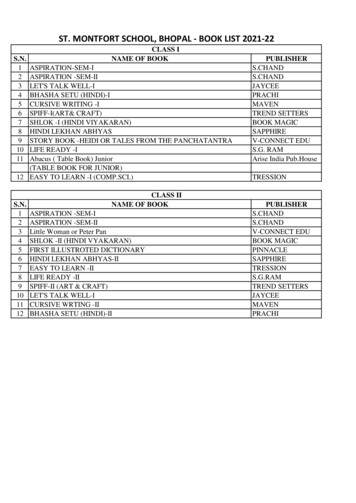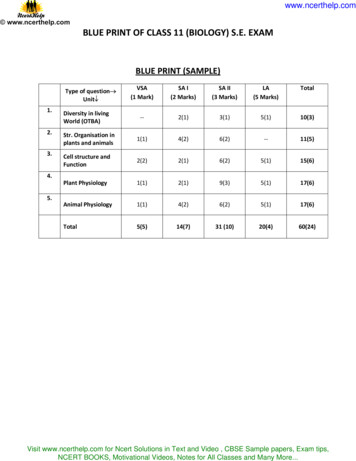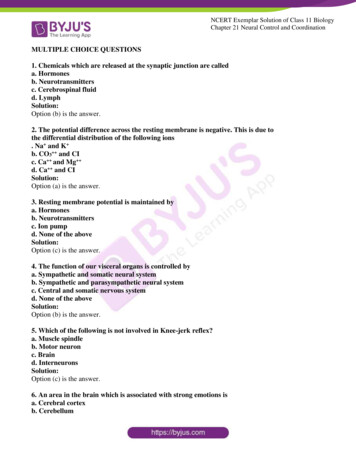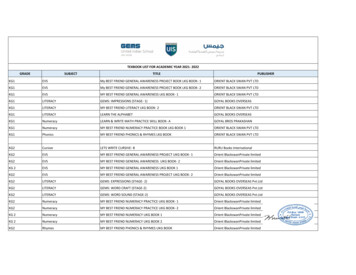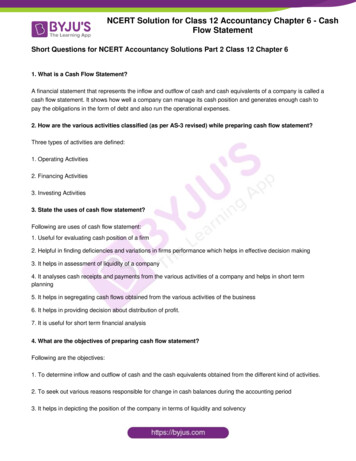
Transcription
NCERT Solution for Class 12 Accountancy Chapter 6 - CashFlow StatementShort Questions for NCERT Accountancy Solutions Part 2 Class 12 Chapter 61. What is a Cash Flow Statement?A financial statement that represents the inflow and outflow of cash and cash equivalents of a company is called acash flow statement. It shows how well a company can manage its cash position and generates enough cash topay the obligations in the form of debt and also run the operational expenses.2. How are the various activities classified (as per AS-3 revised) while preparing cash flow statement?Three types of activities are defined:1. Operating Activities2. Financing Activities3. Investing Activities3. State the uses of cash flow statement?Following are uses of cash flow statement:1. Useful for evaluating cash position of a firm2. Helpful in finding deficiencies and variations in firms performance which helps in effective decision making3. It helps in assessment of liquidity of a company4. It analyses cash receipts and payments from the various activities of a company and helps in short termplanning5. It helps in segregating cash flows obtained from the various activities of the business6. It helps in providing decision about distribution of profit.7. It is useful for short term financial analysis4. What are the objectives of preparing cash flow statement?Following are the objectives:1. To determine inflow and outflow of cash and the cash equivalents obtained from the different kind of activities.2. To seek out various reasons responsible for change in cash balances during the accounting period3. It helps in depicting the position of the company in terms of liquidity and solvency
NCERT Solution for Class 12 Accountancy Chapter 6 - CashFlow Statement4. It also helps in determining the requirement and the corresponding availability of cash for business in future.5. State the meaning of the terms: Cash Equivalents, Cash flows.Cash equivalents are investments that are highly liquid in nature and do not change value easily. Cashequivalents are essential for managing short term cash requirements or any such investments. For exampletreasury bills.Cash Flows: It is the inflow and outflow of cash and cash equivalents. Cash inflows boosts cash balance and cashoutflow has a negative impact on cash balance6. Prepare a format of cash flow from operating activities under indirect method.The format is as follows:
NCERT Solution for Class 12 Accountancy Chapter 6 - CashFlow Statement7. State clearly what would constitute the operating activities for each of the following enterprises:(i) Hotel(ii) Film production house(iii) Financial enterprise(iv) Media enterprise(v) Steel manufacturing unit(vi) Software development business unit.(i) Hotels1. Receipts obtained from sale of goods to customers.2. Customer stay, payments of wages and salaries, food items and electricity are operating activities(ii) Film Production House:1. Receipts obtained from selling of film rights to distributors2. Payment provided to actor, actresses, directors and other employees.(iii) Financial Enterprises:1. Receipts obtained from loan repayments, interest received from investments2. Salary for employees, expenditure incurred for recovering loans, loan repayment etc(iv) Media Enterprises:1. Receipts that are obtained from various advertisements2. Payments made to photographers, employees and reporters(v) Steel Manufacturing Unit:1. Receipts obtained from sale of steel rods, castings and sheets.2. Payments made for purchasing iron, coal and salaries to staff.
NCERT Solution for Class 12 Accountancy Chapter 6 - CashFlow Statement(vi) Software Development Business Unit:1. Receipts obtained for software sales and license renewal2. Payments towards salaries of employees8. “The nature/type of enterprise can change altogether the category into which a particular activity maybe classified.” Do you agree? Illustrate your answer.Yes, it can happen. For example, there are two firms one is engaged in real estate and the other in generalbusiness. For the firm engaged in real estate sale of building will be regarded as part of operating activity while forthe firm dealing with general business, purchase or sale of a building is regarded as an investing activity.Therefore, it can be said that nature and type of enterprise determines the type of activities.Long Questions for NCERT Accountancy Solutions Part 2 Class 12 Chapter 61. Describe the procedure to prepare Cash Flow Statement.Following steps are followed:1. Determine cash flows obtained from operating activities2. Determine cash flows obtained from financing activities3. Determine cash flow obtained from investing activities4. Determine net increase or decrease which is obtained by adding amounts from all the cash flow activities.5. Add the opening balance of cash and the cash equivalents and deduct the same from the amount determinedin the previous step.There are two methods which are used for preparation of cash flow statement1. Direct Method2. Indirect Method.
NCERT Solution for Class 12 Accountancy Chapter 6 - CashFlow Statement
NCERT Solution for Class 12 Accountancy Chapter 6 - CashFlow Statement
NCERT Solution for Class 12 Accountancy Chapter 6 - CashFlow Statement2. Describe "Indirect" method of ascertaining Cash Flow from Operating Activities.In indirect method cash flow statement begins with net income or loss, and thereafter the additions or deductionsfrom that amount for non-cash expense and revenue items, which results in cash flow from operating activities.Following are some items:1. Items that are non-cash in nature like goodwill, depreciation are added towards net profit2. Expenses that are non-operating in nature like transfer to reserve and loss on sale of fixed assets which areadded back to show Net Profit earned.3. Provision such as discount for debtors, doubtful debts, proposed dividends etc. should be added to Net Profit4. Any decrease in current assets and an increase in current liabilities is added to operating profit.Following items get deducted from net profit of P & L account1. Incomes that are non-operating in nature like sale of fixed assets2. Non-trading incomes like dividend received, tax refund, interest received3. Increase in current assets and decrease in current liabilities
NCERT Solution for Class 12 Accountancy Chapter 6 - CashFlow Statement3. Explain the major Cash Inflow and outflows from investing activities.Investing activities consist of sales and purchase of fixed assets that are long term in nature, like building, land,furniture and plant and machinery etc. It also includes sale and purchase of items that are not cash equivalents. Ifany income is received from these assets it is regarded as a part of investing activities. The major cash inflowsand outflows that are involved in investing activities are:1. Cash receipts that are obtained when fixed assets are sold off and it includes intangible assets.2. Acquiring fixed assets which also includes intangibles like goodwill using cash payments, the payments is forthe research and development and assets that are self-constructed.3. Acquiring shares, debt instruments or warrants using cash payments4. Disposal of shares and warrants that yield cash receipts.5. Loans and cash advances that are made to third parties (does not includes loans and advances made byfinancial enterprises.6. Cash receipts obtained from any insurance company for a property that is involved in accident7. Cash receipts that are obtained for repayment of loans and cash advances made to third parties.8. Any type of income that is obtained from fixed assets like interest, dividend and rent (not in case of financialenterprises)
NCERT Solution for Class 12 Accountancy Chapter 6 - CashFlow Statement4. Explain the major Cash Inflows and outflows from financing activities.In a firm, the financing activities are associated with capital or long term funds of the firm, the financing activitiesbring about change in capital and borrowed funds.The following cash inflows and outflows as per AS3 can be mentioned here as:1. Cash received from the issuing of shares and similar instruments causes cash inflow2. Cash received from issuing of debentures, obtaining loans, bonds and similar instruments brings cash inflow.3. Repayments of debentures, loans and bonds in form of cash is considered cash outflow4. Buying back shares and debentures which were issued is also cash outflow5. Interest payment for debentures, advances and loans.6. Dividend payment to equity and preference shareholders.
NCERT Solution for Class 12 Accountancy Chapter 6 - CashFlow Statement
NCERT Solution for Class 12 Accountancy Chapter 6 - CashFlow StatementNumerical Questions for NCERT Accountancy Solutions Part 2 Class 12 Chapter 61. Anand Ltd., arrived at a net income of 5, 00,000 for the year ended March 31, 2017. Depreciation forthe year was 2, 00,000. There was a profit of 50,000 on assets sold which was transferred to Statementof profit and Loss account. Trade Receivables increased during the year 40,000 and Trade Payablesalso increased by 60,000. Compute the cash flow operating activities by the indirect approach.The solution for this question is as follows:Cash Flow from Operating Activities as on March 31, 2017AmountParticulars( )Net Profit during the yearItems to be adjusted:Add: Depreciation2,00,000Less: Gain on sale of assets(50,000)Operating Profit before Working Capital changesAdd: Increase in Trade Payables60,000Less: Increase in Trade Receivables(40,000)Net Cash from OperationsAmount( )5,00,0001,50,0006,50,00020,0006,70,0002. From the information given below you are required to calculate the cash paid for the inventory:Particulars( )Inventory in the beginning40,000Credit Purchases1,60,000Inventory in the end38,000Trade payables in the beginning14,000Trade payables in the end14,500The solution for this question is as follows:Trade Payables AccountDr.DateCr.ParticularsCash (Balancing fig.)Balance c/dJ.F.Amount 1,59,500Date14,5001,74,000Therefore the cash paid for Inventory amounts to 1, 59,500ParticularsBalance b/dPurchasesJ.F.Amount 14,0001,60,0001,74,000
NCERT Solution for Class 12 Accountancy Chapter 6 - CashFlow Statement3. For each of the following transactions, calculate the resulting cash flow and state the nature of cashflow, viz., operating, investing and financing.(a) Acquired machinery for 2, 50,000 paying 20% by cheque and executing a bond for the balancepayable.(b) Paid 2, 50,000 to acquire shares in Informa Tech. and received a dividend of 50,000 afteracquisition.(c) Sold machinery of original cost 2, 00,000 with an accumulated depreciation of 1, 60,000 for 60,000.The solution for this question is as follows:(a)Part payment 50,000 for acquiring machinery 2, 50,000 is related with Investing Activities(b)Amount paid for acquiring sharesDividend receivedNet Cash used in Investing Activities (2,50,000)50,000(2,00,000)Amount paid to acquire assets and dividend received is a part of Investing Activities.(c) Inflow of cash of 60,000 on sale of machinery is a part Investing Activities.4. The following is the Profit and Loss Account of Yamuna Limited:Statement of Profit and Loss of Yamuna Ltd.,for the Year ended March 31, 2017Particularsi)ii)iii)Revenue from OperationsExpensesCost of Materials ConsumedPurchase of Stock-in-tradeOther ExpensesTotal ExpensesProfit before Tax (i – ii)Note No.12Amount( ditional information:(i) Trade receivables decrease by 30,000 during the year.(ii) Prepaid expenses increase by 5,000 during the year.(iii) Trade payables increase by 15,000 during the year.(iv) Outstanding expenses payable increased by 3,000 during the year.(v) Other expenses included depreciation of 25,000.Compute net cash from operations for the year ended March 31, 2017 by the indirect method.
NCERT Solution for Class 12 Accountancy Chapter 6 - CashFlow StatementThe solution for this question is as follows:Cash Flow from Operating Activities of Yamuna Limited as on March 31, 2017AmountParticulars Net Profit earned during the yearItems to be added:DepreciationOperating Profit before Working Capital changesAdd: Increase in Current LiabilitiesOutstanding ExpensesAdd: Decrease in Current AssetsTrade ReceivablesStockLess: Decrease in Current LiabilitiesTrade CreditorsLess: Increase in Current AssetsPrepaid ExpensesNet Cash from OperationsAmount 00)(5,000)(20,000)2,38,0005. Compute cash from operations from the following figures:(i) Profit for the year 2016-17 is a sum of . 10,000 after providing for depreciation of . 2,000.(ii) The current assets and current liabilities of the business for the year ended March 31, 2016 and 2015are as follows:ParticularTrade ReceivablesProvision for Doubtful DebtsTrade PayablesInventoriesOther Current AssetsExpenses payablePrepaid ExpensesAccrued IncomeIncome received in advanceMarch31, 2016( )March31, 2017( 5,0001,20015,0008,00012,0001,5001,0004,0001,000
NCERT Solution for Class 12 Accountancy Chapter 6 - CashFlow StatementThe solution for this question is as follows:Cash Flow Statementfor the Year Ending March 31, 2017ParticularsDetailsAmount( )( )Cash from Operating ActivitiesNet Profit10,000Items to be added:DepreciationOperating Profit before Working Capital AdjustmentsLess: Increase in Current Assets2,000Trade ReceivablesAccrued IncomeAccrued IncomeOther Current toriesAdd: Increase in Current LiabilitiesProvision for Doubtful Debts200Trade Payables2,000Expense PayableAdd: Decrease in Current Assets500Prepaid Expenses(1,000)Less: Decrease in Current LiabilitiesIncome received in advance1,000Net Cash From Operating Activities7,7006. From the following particulars of Bharat Gas Limited, calculate Cash Flows from Investing Activities.Also, show the workings clearly preparing the ledger accounts:Balance Sheet of Bharat Gas Ltd. as on 31 Mar. 2016 and 31 Mar. 2017ParticularsNoteNo.Figures as the endof 2017( )Figures as at theend of reporting 2016( )II) Assets1. Non-current Assetsa) Fixed assetsi) Tangible assetsii) Intangible assetsb) Non-current investmentsNotes12Tangible assets MachineryIntangible assets 002,60,000
NCERT Solution for Class 12 Accountancy Chapter 6 - CashFlow StatementNotesFigures of current yearFigures of previousyear1. Tangible ,00,0002,80,0004,60,0003,80,00010% long term investments1,60,00060,000Investment in landShares of Amartex 002. Intangible AssetsGoodwillPatents3. Non-current InvestmentsAdditional Information:(a) Patents were written-off to the extent of . 40,000 and some Patents were sold at a profit of . 20,000.(b) A Machine costing . 1, 40,000 (Depreciation provided thereon . 60,000) was sold for . 50,000.Depreciation charged during the year was . 1, 40,000.(c) On March 31, 2016, 10% Investments were purchased for . 1, 80,000 and some Investments were soldat a profit of . 20,000. Interest on Investment was received on March 31, 2017.(d) Amartax Ltd. paid Dividend @ 10% on its shares.(e) A plot of Land had been purchased for investment purposes and let out for commercial use and rentreceived . 30,000.
NCERT Solution for Class 12 Accountancy Chapter 6 - CashFlow StatementThe solution for this question is as follows:Cash Flow from Investing ActivitiesParticularsAmountAmount Cash InflowProceeds from Sale of Patents1,00,000Proceeds from Sale of Machinery50,000Proceeds from Sale of 10% Long-term Investment1,00,000Interest received on 10% Long-term Investment6,000Dividend Received from Amartax Ltd.10,000Rent Received30,0002,96,000Cash OutflowPurchase of Goodwill(2,00,000)Purchase of Machinery(4,40,000)Purchase of 10% Long-term Investment(1,80,000)(8,20,000)Net Cash used in Investing Activities(5,24,000)Patents AccountDr.Cr.AmountDateParticularsBalance b/dJ.F. 2,80,000AmountDateParticularsProfit and Loss (writtenJ.F. 40,000off)Profit and20,000Loss (Profit on sale)Bank (sale- Balancing1,00,000figure)Balance c/d3,00,0001,60,0003,00,000
NCERT Solution for Class 12 Accountancy Chapter 6 - CashFlow StatementMachinery AccountDr.Cr.AmountDateParticulars J.F.Balance b/dDate10,20,000Bank (Purchases- BalancingAmount4,40,000ParticularsJ.F.Depreciation 1,40,000Bank50,000Profit and Loss30,000figure)Balance c/d12,40,00014,60,00014,60,00010% Long-term Investment AccountDr.Cr.AmountDateParticularsJ.F.Balance b/d 60,000BankAmountDateParticularsJ.F. Bank (Balancing figure)1,00,000Balance c/d1,60,0001,80,000Profit and Loss (Profit20,000on sale)2,60,0002,60,0007. From the following Balance Sheet of Mohan Ltd., prepare cash flow Statement:Balance Sheet of Mohan Ltd.,as at 31st March 2016 and 31 March 2017ParticularsI) Equity and Liabilities1. Shareholders’ Fundsa) Equity share capitalb) Reserves and surplus2. Non-current liabilitiesa) Long-term borrowings3. Current liabilitiesTrade payablesShort-term provisionsNote No.March 31, 2017( )March 31, 2016( ,20,00070,0001,40,00060,000
NCERT Solution for Class 12 Accountancy Chapter 6 - CashFlow StatementTotal7,70,000II) Assets1. Non-current assetsFixed assets2. Current assetsa) Inventoriesb) Trade receivablesc) Cash and cash 0Notes to accounts:201720161. Long-term borrowingsBank Loan80,0001,00,00070,00060,0003. Fixed assetsLess: Accumulated Depreciation6,00,0001,00,0004,00,00080,000(Net) Fixed ,0001,20,00030,00090,0002. Short-term provisionProposed dividend4. Trade receivablesDebtorsBills receivables5. Cash and cash equivalentsBankAdditional Information:Machine Costing . 80,000 on which accumulated depreciation was . 50,000 was sold for . 20,000.The solution for this question is as follows:Cash Flow Statement of Mohan Ltd.A.ParticularsCash Flow from Operating ActivitiesAmount Amount Profit as per the Balance Sheet (2,00,000 – 1,60,000)Proposed DividendNet Profit before Taxation and Extraordinary items40,00070,0001,10,000
NCERT Solution for Class 12 Accountancy Chapter 6 - CashFlow StatementAdjustments:DepreciationLoss on Sale of Machine70,00010,00080,000Operating Profit before Working Capital changes1,90,000Add:Decrease in Current AssetsDebtorsLess:40,00040,0002,30,000Increase in Current AssetsInventoriesBills Receivable(20,000)(10,000)Less:Decrease in Current LiabilitiesTrade Payables(20,000)(50,000)Net Cash from Operations1,80,000B.Cash Flow from Investing ActivitiesProceeds from Sale of Fixed Assets20,000Purchases of Fixed Assets(2,80,000)Net Cash outflow from Investing activity(2,60,000)C.Cash Flow from Financing ActivitiesIssue of SharesBank Loan PaidDividend Paid1,00,000(20,000)(60,000)Net Cash from Financing Activities20,000D.Net Decrease in Cash and Cash Equivalents (A B C)(60,000)Add:Cash and Cash Equivalents inthe beginning90,000E.Cash and Cash equivalents at the end30,000
NCERT Solution for Class 12 Accountancy Chapter 6 - CashFlow StatementFixed Assets AccountDr.Cr.DateParticularsJ.F.Balance b/dAmount DateJ.F.Bank4,00,0002,80,000Bank (Purchases- Balancing fig.)ParticularsAmount 20,00010,000Profit and LossAccumulated Depreciation50,0006,00,000Balance c/d6,80,0006,80,000Accumulated Depreciation AccountDr.DateCr.ParticularsFixed AssetsBalance c/dJ.F.Amount DateParticularsJ.F.Balance b/d50,0001,00,00080,000Profit and Loss (Balance fig.)70,0001,50,0001,50,0008. From the following Balance Sheets of Tiger Super Steel Ltd., prepare Cash Flow Statement:Balance Sheet of Tiger Super Steel Ltd.as at 31st March 2014 and 31st March 2017ParticularsI) Equity and Liabilities1. Shareholders’ Fundsa) Share capitalb) Reserves and surplus2. Current Liabilitiesa) Trade payablesb) Other current liabilitiesc) Short-term provisionsTotalII) Assets1. Non-Current Assetsa) Fixed assetsi) Tangible assetsii) Intangible assetsb) Non-current investmentsNote No.March 31, 2017( )March 31, 2016( 014,0003,20022,4002,14,80062. Current Assetsa) Inventoriesb) Trade receivablesc) Cash and Cash EquivalentsTotalAmount 031,20043,20011,20034,00030,0006,8001,74,800
NCERT Solution for Class 12 Accountancy Chapter 6 - CashFlow StatementNotes to accounts:201720161. Share CapitalEquity share eneral reserve12,0008,000Balance in statement of profit and rovision for taxation12,80011,200Proposed dividend15,60011,20028,40022,400Land and 0% Preference share capital2. Reserves and surplus3. Trade payablesBills payable4. Other current liabilitiesOutstanding expenses5. Short-term provisions6. Tangible assetsAdditional Information:Depreciation Charge on Land & Building 20,000, and Plant 10,000 during the year.The solution for this question is as follows:Cash Flow Statement of Tiger Super Steels LtdA.ParticularsCash Flow from Operating ActivitiesProfit as per the Balance Sheet (10,800 –7,200)General ReserveProposed DividendProvision for TaxationAmount Amount 3,6004,00015,60012,800Net Profit before Taxation and Extraordinary36,000Items to be added:Depreciation on Land and BuildingDepreciation on Plant20,00010,000
NCERT Solution for Class 12 Accountancy Chapter 6 - CashFlow StatementGoodwill written off5,20035,200Operating Profit before Working Capital changes71,200Add:Increase in Current LiabilitiesBills PayableDecrease in Current crease in Current AssetsTrade ReceivablesLess:(13,200)Decrease in Current LiabilitiesOutstanding Expenses(800)(14,000)Cash Generated from Operating ActivitiesLess:Income Tax paid67,200(11,200)Net Cash from Operating Activities56,000B.Cash Flow from Investing ActivitiesPurchases of PlantPurchases of Investment(40,400)(20,000)Net Cash used in Investing Activities(60,400)C.Cash Flow from Financing ActivitiesIssue of Equity SharesDividend paidRedemption of 10% Preference Shares40,000(11,200)(20,000)Net Cash from Financing Activities8,800D.Net Increase in Cash and Cash Equivalent4,400Add:Cash and Cash Equivalent in thebeginning6,800E.Cash and Cash Equivalents at the end11,200
NCERT Solution for Class 12 Accountancy Chapter 6 - CashFlow StatementWorking Notes:1.Plant AccountDr.DateCr.ParticularsTo Balance b/dJ.F.Amount DateParticularsBy DepreciationJ.F.36,000To Bank A/c (Purchases- Balancingfigure)10,00050,40086,400By Balance c/d76,40086,4002.Net Profit before Tax3,600Profit and Loss Account12,800Less: Provision for Tax16,4009. From the following information, prepare cash flow statement:ParticularsNote No.31st March2015( )31st March2014( )I) Equity and Liabilities1. Shareholders’ Fundsa) Share capitalb) Reserves and surplus2. Non-current Liabilities7,00,0004,70,0005,00,0002,50,000(8% Debentures)3. Current Liabilitiesa) Trade 9,50,000a) Fixed assetsi) Tangibleii) 02. Current assetsa) Inventoriesb) Trade Receivables6,00,0006,00,0005,00,0004,00,000c) Cash and cash II) Assets1. Non-current assetsTotalAdditional Information:Amount
NCERT Solution for Class 12 Accountancy Chapter 6 - CashFlow StatementDepreciation Charge on Plant amount to . 80,000.Cash Flow Statementfor the year ending March 31, 2015ParticularsA.DetailsAmount( )( )Cash from Operating ActivitiesNet Profit2,20,000Items to be Added:Interest on Debentures48,000Depreciation on Fixed Assets80,000Goodwill Written-off80,000Operating Profit before Working Capital Adjustments2,08,0004,28,000Add: Increase in Current LiabilitiesCreditors3,00,000Less: Increase in Current AssetsInventories(1,00,000)Trade Receivables(2,00,000)Cash Generated from Operations4,28,000Less: Tax Paid-Net Cash From Operating ActivitiesB.4,28,000Cash From Investing ActivitiesPurchase of Fixed Assets (WN)(2,80,000)Net Cash From Investing ActivitiesC.-(2,80,000)Cash From Financing ActivitiesIssue of Share CapitalRedemption of DebenturesInterest Paid on Debentures2,00,000(2,00,000)(48,000)(48,000)Net Cash From Financing Activities (C)(48,000)Net Increase in Cash (A B C)1,00,000Add: Opening Cash and Cash EquivalentsClosing Cash and Cash Equivalents3,00,0004,00,000
NCERT Solution for Class 12 Accountancy Chapter 6 - CashFlow StatementWorking Note:Fixed Assets AccountDr.Cr.ParticularsJ.F.AmountParticulars( )Balance b/d5,00,000DepreciationPurchases (Balancing Figure)2,80,000Balance c/dAmountJ.F.( )80,0007,00,0007,80,0007,80,00010. From the following Balance Sheet of Yogeta Ltd., prepare cash flow statement:ParticularsI) Equity and Liabilities1. Shareholders’ Fundsa) Share capitalb) Reserves and surplus-Surplus2. Non-current Liabilitiesa) Long-term borrowings3. Current Liabilitiesa) Short-term borrowings(Bank overdraft)b) Trade payablesc) Short-term provision(Provision for taxation)TotalII) Assets1. Non-current assetsa) Fixed assetsi) Tangible2. Current assetsa) Inventoriesb) Trade Receivablesc) Cash and cash equivalentsTotalNote No.31st March2017( )31st March2016( 0009,70,0006,00,000Notes to AccountsParticulars1. Share capitala) Equity share capitalb) Preference share capital31st March2017( )3,00,0001,00,0004,00,00031st March2016( )2,00,0002,00,000
NCERT Solution for Class 12 Accountancy Chapter 6 - CashFlow Statement2. Long term borrowingsLong-term loanLong-term nal Information:Net Profit for the year after charging . 50,000 as Depreciation was . 1, 50,000. Dividend paid on Sharewas . 50,000, Tax Provision created during the year amounted to . 60,000.The solution for this question is as follows:Cash Flow Statement of Yogeta Ltd.ParticularsA.AmountAmount Cash Flow from Operating ActivitiesProfit as per Balance Sheet (2,00,000 –1,00,000)1,00,000Proposed Dividend50,000Provision for Taxation60,0002,10,000Net Profit before Taxation and Extraordinary itemsItems to be added:Depreciation50,000Operating Profit before Working Capital changes50,0002,60,000Add: Increase in Current liabilitiesTrade Payable20,00020,0002,80,000Less: Increase in Current AssetsInventories(70,000)Trade Receivable(50,000)Cash Generated from Operating ActivitiesLess: Income Tax paidNet Cash from OperationsB.1,60,000(40,000)1,20,000Cash Flow from Investing ActivitiesPurchases of Fixed AssetsNet Cash used in Investing ActivitiesC.(1,20,000)(3,50,000)(3,50,000)Cash Flow from Financing ActivitiesIssue of Equity Shares1,00,000Issue of Preference Shares1,00,000Loan from Rahul1,30,000
NCERT Solution for Class 12 Accountancy Chapter 6 - CashFlow StatementLess: Repayment of Loan(2,00,000)Dividend Paid(50,000)Net Cash from Financing ActivitiesD.80,000Net decrease in Cash and Cash Equivalent (A B C)(1,50,000)Add: Cash and Cash Equivalents in the beginningE.50,000Cash and Cash Equivalents at the end (Bank Overdraft)(1,00,000)Working Notes:1.Provision for Taxation AccountDr.Cr.AmountDateParticularsJ.F. AmountDateParticularsJ.F. Bank (Balancing figure)40,000Balance b/d30,000Balance c/d50,000Profit and Loss60,00090,00090,0002.Fixed Assets AccountDr.Cr.AmountDateParticularsJ.F. AmountDateParticularsBalance b/d4,00,000DepreciationBank3,50,000Balance c/d7,50,000J.F. 50,0007,00,0007,50,000
NCERT Solution for Class 12 Accountancy Chapter 6 - CashFlow Statement11. Following is the Financial Statement of Garima Ltd., prepare cash flow statement.ParticularsI) Equity and Liabilities1. Shareholders’ Fundsa) Share capitalb) Reserve and surplus-SurplusNote No.31st March2017( )122. Current Liabilitiesa) Trade payablesc) Short-term provisions(Provision for taxation)TotalII) Assets1. Non-current assetsa) Fixed assetsi) Tangible2. Current assetsa) Inventoriesb) Trade receivablesc) Cash and cash equivalentsd) Other current assetsTotal31st March2016( 0Notes to AccountsParticulars1. Share capitala) Equity share capitalb) Preference share capital31st March2017( )3,00,0001,40,0004,40,0002. Reserve and surplusSurplus in statement of profit and loss at the beginning of the year28,000Add: Profit of the yearLess: Dividend16,0004,000Profit at the end of the year40,000Additional Information:1. Interest paid on Debenture 6002. Dividend paid during the year 4,0003. Depreciation charged during the year 32,00031st March2016( )2,00,00080,0002,80,000
NCERT Solution for Class 12 Accountancy Chapter 6 - CashFlow StatementThe solution for this question is as follows:Cash Flow Statement (Indirect Method)ParticularsA.AmountAmount Cash Flow from Operating ActivitiesProfit as per Balance Sheet (40,000 – 28,000)12,000Proposed DividendProvision for Taxation4,00012,000Net Profit before Taxation and Extraordinary items28,000Items to be added:Interest paid on DebenturesDepreciation60032,000Operating Profit before Working Capital changes32,60060,600Add: Increase in Current liabilitiesTrade Payables1,00,000Less: Increase in Current AssetsOther Current AssetsInventoriesTrade ReceivablesCash generated from Operating ActivitiesLess: Income Tax paidNet Cash used in Operating ActivitiesB.Net Cash used in Investing ,96,000)(1,96,000)Cash Flow from Investing ActivitiesIssue of Equ
2. Describe "Indirect" method of ascertaining Cash Flow from Operating Activities. In indirect method cash flow statement begins with net income or loss, and thereafter the additions or deductions from that amount for non-cash expense and revenue items, which results in cash flow from operating activities. Following are some items: 1.
